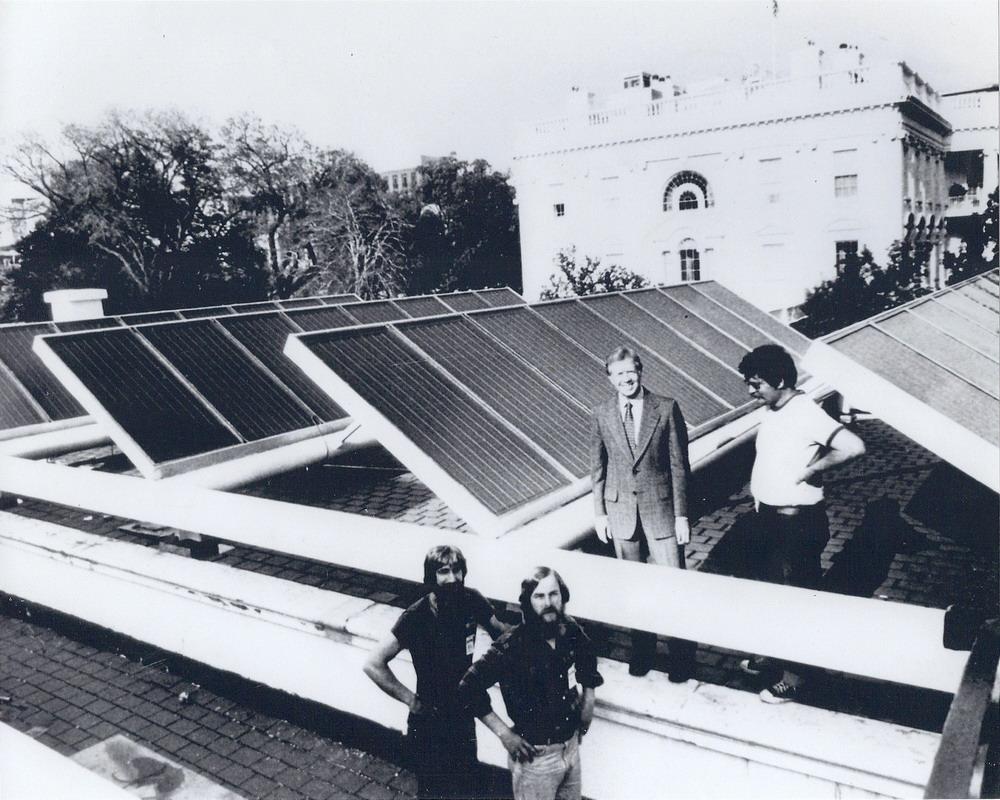In the late 1970s, the peanut farmer from Plains, Georgia became the first American president to promote solar as a path to American energy independence and freedom from foreign oil. Now, at 92, his family is turning 10 acres of the family peanut farm into a 1.3-megawatt solar farm.
On February 8th, President Carter and his family attended a ground-breaking ceremony for a new solar project built under a lease agreement with Atlanta-based developer SolAmerica. The project, located on the Carter family farm, covers 10 acres and is projected to produce more than 55 million kilowatt-hours of energy in the next 25 years. The 3,852 solar panels will provide more than half of the power needs for the residents of the tiny town of Plains, population 683.
The soft-spoken 39th president held a press conference at the local high school to discuss the new solar farm. Recognizing that this project is going in at a time of great uncertainty for the American energy sector, President Carter said, “I hope that we’ll see a realization on the part of the new administration that one of the best ways to provide new jobs — good-paying and productive and innovative jobs — is through the search for renewable sources of energy…I haven’t seen that happen yet, but I’m still hoping for that.”
Jimmy Carter was a one-term president who served at one of the most turbulent times in American history. Elected as a candidate for change after the scandal-ridden Nixon/Ford administration, the Democrat Governor of Georgia was a refreshingly earnest outsider, and very much a president with a positive vision for change. Unfortunately, political upheaval in the Middle East brought about the OPEC oil embargo and the Iranian hostage crisis, and despite continued recovery from the recession of the Ford years, The second half of his administration was plagued by inflation, high-interest rates, oil shortages, and slow economic growth. Americans voted to replace him with Ronald Reagan—a former Hollywood actor— in an election that had many similarities to our current political situation.

During his presidency, Jimmy Carter made significant contributions to launching the solar industry in the United States. A former nuclear submarine officer in the navy, Carter has a background in science a deep understanding of advanced technology. Although he did not found the National Renewable Energy Laboratory (NREL), he increased funding significantly during the energy crisis. In 1977, he established the Solar Energy Research Institute (SERI) in Golden Colorado and set a goal for installation of solar energy in more than two and one-half million houses by 1985. He even famously installed solar on the White House to show that he was “walking the talk.”
President Reagan, much like President Trump today, was a skeptic on the topic of solar power. One of his first acts as president was to have the solar panels removed from the White House in a symbolic gesture of loyalty to the fossil fuel industry. He slashed funding to solar programs, stifling the development of advanced energy systems for over a decade.

There are lessons to be learned from the demise of the 1970s solar industry. Tax credits and federal incentives created a market that simply wasn’t ready to stand on its own during the Carter administration, and a lot of untested products were rushed to market to take advantage of the boom. Although Obama-era incentives brought about a few notorious failures like Solyndra, The current PV industry is powered by a global market, not just a few government incentives. Unlike Ronald Reagan before him, Donald Trump can’t easily pull the plug on an industry that is currently one of the brightest spots in the U.S. economy.
“I’m afraid — and hope that I’m wrong — that Trump might do the same thing that Ronald Reagan did and say we can be sufficient ourselves without renewable energy,” Mr. Carter told the New York Times at the recent ceremony at his farm. “But I hope he doesn’t do that.”
After the ribbon cutting, former First Lady Rosalynn Carter said, “It’s very special to me because I was so disappointed when the panels came off of the White House, and now to see them in Plains is just terrific.”





